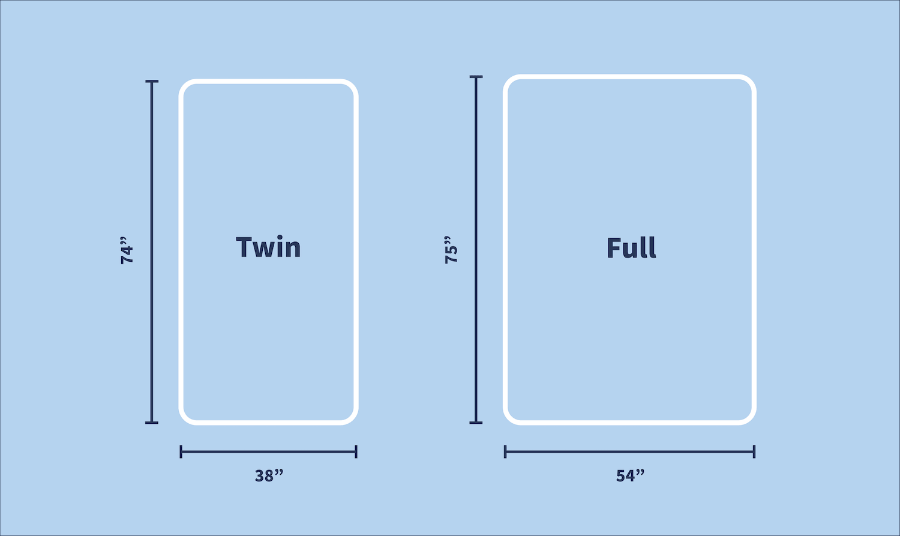Twin vs. Full Mattress
Disclosure: By clicking on the product links in this article, Mattress Nerd may receive a commission fee at no cost to you, the reader. Read full disclosure statement.
Although it may seem simple to determine if you need a twin size, full size, queen size, or king size mattress, there are actually some major differences that you need to consider before making a purchase, especially if you’re choosing between a twin size or full size.
Twin size and full size mattresses are some of the most popular mattress sizes. Below, we cover some of the most important differences between twin size and full size mattresses to help you pick out the right option so you can get a better night’s sleep.
| Twin | Full | |
| Height | 11” | 11” |
| Width | 38” | 54” |
| Surface Area | 2,850” | 4,050” |
| Average Cost | $699 | $899 |
| Who it’s best for | Young children | Teenagers, shorter adults |
| Mattress Options | Best Mattress for Kids | Best Full-Size Mattress |

Twin and Full Similarities
Twin beds and full size beds are both known for being very compact compared to their larger counterparts: queen and king size. If you’re looking to put your bed in a smaller room, like children’s bedrooms or dorms, then you’ll want to go with one of these two options.
The smaller size of these mattresses also makes them ideal for children or younger teenagers who don’t need the extra space that a queen size mattress or king size mattress provides. Twin and full size mattresses are less expensive than larger mattresses because they have smaller bed frames and use fewer construction materials, making them a great budget sleep option as well.
Twin and Full Differences
The primary difference in twin and full size mattresses is in their widths. A twin size mattress is usually around 38 inches wide, whereas a full-size mattress comes with approximately 54 inches of width.
This means that the twin size mattress is better suited for younger children who have just grown out of the crib, and teenagers with smaller frames. Meanwhile, full size mattresses are wide enough to accommodate teenagers and smaller adults.
Considerations When Mattress Shopping
We spend about a third of our lives sleeping, so a mattress purchase is a major investment. That means you need to take careful consideration before buying one. There is no one-size-fits-all solution for every single person when it comes to mattress options. You need to look into the following factors to pinpoint a single bed that best fits a specific sleep personality.
Age
Children who are leaving their crib mattress behind and moving onto their first starter beds will need a smaller mattress, such as a standard twin. As they grow into adolescence, it’s a good idea to transition them over to a twin XL mattress, or a full size mattress.
When they’re teenagers, they can stay with the full size, or they can move on to a queen size bed, depending on how much personal space they want when they sleep. It’s typically not necessary for a teenager to go with a queen or king size mattress since they’re more for single adults or couples that share a bed.
Cost
There is usually a small gap between the pricing on a twin size and a full size bed (with twins being the cheaper option). If you are looking for a more affordable mattress, you’ll want to go with a twin, but you should not sacrifice comfort and accommodation. Ultimately, you need a mattress that will ensure the sleeper gets the good night’s rest they deserve.
Take a look at our best affordable mattresses article to learn more.
Size of Room
The one big advantage that twin size and full size mattresses have over larger sleep options is that they have a more compact form. This means they’re better for fitting into smaller room sizes, such as children’s rooms and college dorm rooms.
If you want to put your bed in a smaller room in your home, or if you simply want to minimize the amount of space your bed takes up so that you can fill in the rest of the room with your other belongings, a twin or full size bed may be your best choice.
However, as mentioned previously, it’s crucial that you keep comfort as a priority. You want to ensure the sleeper isn’t forced to rest on a sleeping space that may be too small for them.
Pros and Cons
Both twin size and full size mattresses have their own sets of pros and cons. It’s important that you weigh these options carefully to ensure that you’re getting the best out of your mattress choice.
Twin Size Mattress Pros
- Features enough space for growing children, especially those who have just moved out of their crib.
- Small and compact enough to easily move around, making for easier remodeling and reorganizing.
- Can be used for bunk beds if you have two children around the same size.
- One of the cheapest mattress sizes available.
- Great for small bedrooms.
If you’re intrigued, head over to our best Twin mattresses page.
Twin Size Mattress Cons
- Too small for couples that share a bed, and many single adults.
Full Size Mattress Pros
- The extra length makes it large enough for older children, teenagers, and smaller adults.
- Can easily fit into guest bedrooms, dorm rooms, studio apartments, and some smaller bedrooms.
- Features an affordable price compared to queen, king, and California king size mattresses.
Sound like the right size for you? Check out our best Full mattress page.
Full Size Mattress Cons
- Heavier and larger than twin mattresses.
- Too small for couples that share a bed, and taller individuals.
Which One is Right for You?
Finding the best mattress for you can be difficult because of the various features and aspects to consider. At the end of the day, you’ll want to be sure that your mattress is large enough to accommodate you so that you won’t be hanging off the edges of the bed while you sleep. Look carefully at the mattress dimensions to determine if you’ll be fine with a twin, full, queen, or king.


